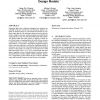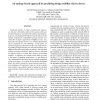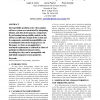147 search results - page 10 / 30 » The structure and value of modularity in software design |
119
click to vote
SIGSOFT
2003
ACM
16 years 17 days ago
2003
ACM
Automated finite-state verification techniques have matured considerably in the past several years, but state-space explosion remains an obstacle to their use. Theoretical lower b...
102
click to vote
METRICS
2003
IEEE
15 years 5 months ago
2003
IEEE
Predicting stability in object-oriented (OO) software, i.e., the ease with which a software item evolves while preserving its design, is a key feature for software maintenance. In...
126
click to vote
WOSP
2000
ACM
15 years 4 months ago
2000
ACM
Interoperability problems arise when complex software systems are constructed by integrating distinct, and often heterogeneous, components. By performing interoperability analysis...
156
click to vote
Publication
A major difficulty in compiler development regards the proper modularization of concerns among the various compiler phases. The traditional object-oriented development paradigm ha...
COMPUTER
2002
14 years 11 months ago
2002
rs use models or abstractions that hide low-level implementation details. Various kinds of representations such as data models, state-transition models, and dataflow models can hel...



